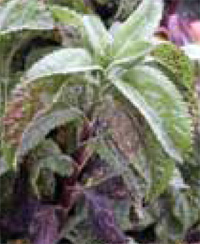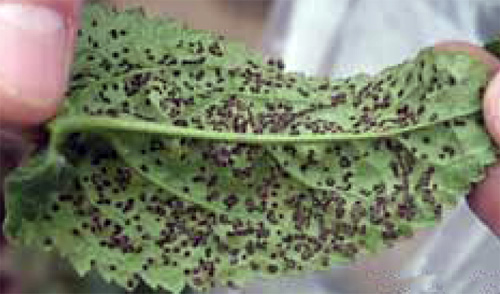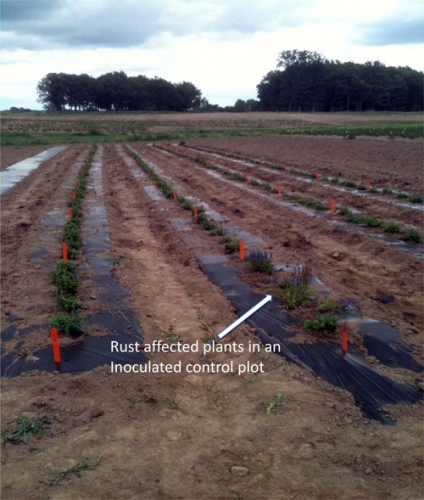Veronica rust observed this season
Herbaceous perennial growers and retailers are encouraged to scout their Veronica (speedwell) for rust symptoms. Management includes disposal of infected plants and preventative fungicides.
In the last week I have had several reports of Veronica rust, Puccinia veronicae-longifoliae, showing up in retail garden centers and wholesale nursery growing operations on perennial Veronica spp.
However, this fungus can also attack annual Veronica species. The following information is what we currently know about this disease and what research will take place at MSU over the next few months.
Hosts
Veronica longifolia ,V. Montana and V. spicata.
Symptoms
Symptoms include bronze, purplish-overcast on the upper surface of infected foliage and raised, reddish-brown pustules on the underside of foliage. When the disease is severe, significant foliar blighting occurs.
Spread
This disease was unintentionally introduced to Michigan in 2004 and was found again in 2005. The disease occurred on field-grown Veronica. To date, it has been a problem in very few nurseries. Long- distance disease spread is thought to occur when infected propagation material is moved. Spores produced on foliage are carried by wind currents. Keep overhead watering to a minimum as this practice will reduce the spread of rust and other foliar pathogens that can attack this plant.
Management
Carefully inspect incoming plant material for signs of rust; pay particular attention to material that originated offshore. Plants with rust pustules or other disease symptoms should be destroyed. If only a small number of plants are infected, removing rust-infected leaves may help to reduce the spread. Fungicide applications are needed for disease control in some situations and must be used preventively rather than curatively. Resistance development is a concern – follow recommended fungicide resistance management strategies listed below, rotating applications between chemical classes.

Veronica rust plant. Photo credit: Mike Bryan, MDA.

Raised rust pustules on the underside of a Veronica leaf. Photo credit: Mike Bryan, MDA.

Foliar blighting of field-grown Veronica caused by rust. Photo credit: Mike Bryan, MDA.
Fungicides labeled for use on ornamentals and are helpful in controlling rusts in general include Heritage (azoxystrobin), Legend, Daconil (chlorothalonil), Cygnus (kresoxim-methyl), Manzate (mancozeb), Eagle (myclobutanil), Banner Maxx (propiconazole), and Armada (triadimefon and trifloxystrobin). Resistance management should be a concern. Growers should note that although there are several labeled products, many of them represent similar types of chemistry. Azoxystrobin, kresoxim-methyl and trifloxystrobin are all strobilurins, and therefore have similar modes of action. Resistance to one of these products may confer resistance to the other two as well. Propiconazole, myclobutanil and triadimefon are all demethylation inhibitors (DMIs). Chlorothalonil, mancozeb and maneb have multi-site activity and, therefore, pathogens are less likely to develop resistance to these products; these fungicides are commonly referred to as broad-spectrum fungicides.
Applications of strobilurins should be alternated with fungicides that have a different mode of action, like DMI fungicides. For both DMIs and strobilurins, it is also prudent to tank-mix with a multi-site product. Additionally, a broad-spectrum fungicide should be applied in alternation with these products. Fungicides should be applied with a 7 to 14 day application interval. In situations where rust symptoms are present, plants with visible rust symptoms should be destroyed.
Future research
Dr. William Kirk, Department of Plant Pathology at MSU, will be conducting an extensive fungicide trial later this season (2011) and evaluating seven fungicides on Veronica “Royal Candles” plants that were infected with the rust. We hope to learn more information about fungicides that could help prevent this serious disease.
For more information on this pest, email Thomas Dudek, Willie Kirk or Jan Byrne. If you suspect your plants have this disease or any other unknown pest, you can submit samples to MSU Diagnostic Services.

2011 Veronica rust trial at Clarksville Horticultural Research Station.
Click here to see zoomed in picture
Dr. Kirk's work is funded in part by MSU's AgBioResearch.



 Print
Print Email
Email